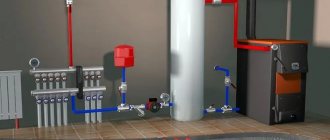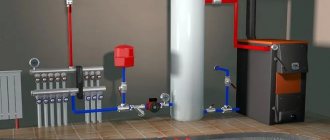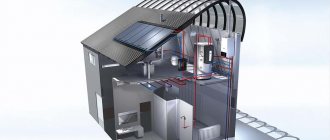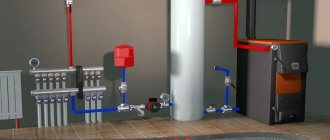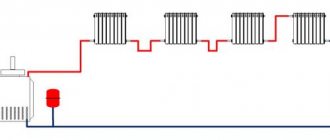It’s easy to calculate how much money is spent on electricity in an apartment. You go to the meter and look - and so on every month. What's in the apartment? Washing machine, TV, computer and a dozen light bulbs.
A completely different story is a private house. It is sometimes impossible to understand where such a figure comes from in a month, even for those who live in the house.
What if you are still a city dweller? If you still have plans to build a private house, and you are afraid that you will not be able to maintain it?
This is where our top-down calculations will help you - where the electricity goes in a private home.
Cost of heating with electricity in a house
The most expensive expense item in a private home is the cost of heating with electricity, if you have heating with an electric boiler. With the cost of 1 kilowatt per hour around 3 rubles, let’s calculate how much it will cost.
For simplicity, let’s calculate the area of the house as 100 square meters. And then everyone will be able to calculate how much it will cost him to heat his house with a specific area.
While there is no gas and you heat with electricity? Prepare 50-60 thousand rubles for the heating season for a house of 100 sq.m.
For every 10 square meters of a well-insulated house, you will need 1 kilowatt of electric boiler power. For 100 square meters you will need a boiler with a capacity of at least 10 kilowatts.
Electricity consumption for heating with such a boiler power will be 10 kilowatts per hour in cold weather - the boiler will operate continuously. Total 240 kilowatt-hours per day. If you have frosts below -30C for a month, then your electric boiler will consume 7200 kilowatt-hours of electricity. Isn't it weak? More than 7 megawatts per month! Which will cost you more than 20 thousand rubles just to heat your home.
However, in practice, such frosts occur in central Russia and even in the Urals for no more than 1-2 weeks during the winter. Sometimes, in some winters, however, there are prolonged frosty periods, as, for example, in the winter of 2013.
The rest of the time, when winter temperatures fluctuate at -15C -20C, the boiler operates half the time. That is, your approximate cost of heating a house of 100 square meters will be equal to 10 thousand rubles per month.
These are the winter months - December, January and February. In November and March, the boiler will operate only 8 hours a day at full capacity, or gradually consume only a third of the electricity. This means that in November and March your electricity costs for heating your house will be approximately 6-7 thousand rubles.
In October and April, the cost of heating with electricity will be completely insignificant - 2-3 thousand rubles.
To summarize, the total cost of heating a well-insulated house with an area of 100 square meters in central Russia and the Urals will be 50-60 thousand rubles for the entire heating season. And the practice of heating with electricity confirms this.
Of course, if you have gas or heat your house with a solid fuel boiler, then you can omit these calculations.
Washing machine: 124–226 kWh per year
How much does he spend?
It all depends on what parameters the washing machine has and how often you use it. If you run the wash 3 times a week in the standard mode without drying, in a month you will get approximately 17.4 kWh, or 83 rubles, and in a year - 226.2 kWh, or 1102 rubles. This is for the most expensive energy consumption class:
| Energy efficiency class | Average energy consumption for 1 wash cycle, kWh | Average energy consumption for 156 wash cycles per year, kWh | Average cost of energy consumption per year, rub. |
| A+++ | 0,8 | 124,8 | 608 |
| A++ | 0,9 | 140,4 | 684 |
| A+ | 1,02 | 159,12 | 775 |
| A | 1,14 | 177,84 | 866 |
| B | 1,30 | 202,8 | 988 |
| WITH | 1,45 | 226,2 | 1102 |
How to save money
Firstly, you can wash in more economical modes.
The energy consumption class of a washing machine does not apply to all modes, but only to a specific one. This information can be found in the instructions.
Konstantin Polyantsev equipment repair specialist
4,99 353
Open profile
Most everyday items can be washed at a temperature of 30–40° in eco mode, and more serious washing can be run with a full load in short cycles of 15–30 minutes - this way you can save electricity consumption without much effort.
Secondly, even when choosing a machine, refuse additional functions. For example, washing machines and dryers burn 2 times more electricity - and at the same time they themselves are more expensive.
Cost of lighting in a private house
If you install energy-saving lamps with an average power of 13-15 watts in all the lamps in your home, which is equivalent to a regular lamp of 75 watts, then your costs for lighting your home will be within very reasonable limits.
In winter, lighting operates for 10 hours a day, and in summer – for 3-5 hours, excluding external lighting. Of course, if external lighting is installed correctly and equipped with light and motion sensors, then external lighting will work no more than internal lighting.
Modern sensors make home and garden lighting efficient and cost-effective.
So, you have a house of 100 sq.m., in which you have approximately 20 lamps with a power of 15 watts. That's only 300 watts per hour. With an average lighting time of 7 hours (both in winter and summer), this is only 2 kilowatts per day or 60 kilowatts per month.
That is, the cost of lighting in a private house of 100 square meters will amount to no more than 200 rubles per month.
How many kilowatts do our home assistants consume?
When building a house and thinking about its arrangement, you should remember that by government decision the consumption of a private home is limited to 15 kW. How to calculate the power consumed by the entire house? The answer is simple: all you need to do is know the energy consumption of each household electrical appliance.
The table below shows approximate energy consumption values for some of the most common household appliances. These figures can be used to estimate the amount of general house energy consumption:
Appliances
| Household appliances | Energy consumption, W |
| Electric kettle | 900-2100 |
| Toaster | 700-1400 |
| Coffee machine | 1000-1300 |
| Electric stove | 1900-4600 |
| Dishwasher | 1800-2750 |
| Microwave | 850-1200 |
| Fridge | 250-800 |
| Electric meat grinder | 700-1500 |
| TV | 700-350 |
| Radio | 25-50 |
| Computer | 350-600 |
| Music Center | 190-450 |
| light bulb | 10-150 |
| Oven | 1200-2500 |
| Air purifier | 50-300 |
| Iron | 700-1800 |
| Boiler | 1200-2000 |
| Vacuum cleaner | 450-2100 |
| Heater | 1100-2500 |
| Fan | 15-200 |
| Air conditioner | 1500-3100 |
| Washing machine | 1700-2700 |
| Hairdryer | 500-2000 |
Power tools
| Electric planer | 500-900 |
| Electric saw | 700-1900 |
| Hammer | 650-2200 |
| Grinder | 900-2100 |
| Jigsaw | 350-750 |
As an example, let's estimate the power consumed by the house. Let's say your home is equipped with a minimum set of household appliances: lighting, refrigerator, microwave, washing machine, TV, computer, vacuum cleaner, iron and dishwasher. Adding their respective powers, we get the figure 8750 W. However, it practically never happens that the entire set of devices is put into operation at the same time, so the result obtained can be safely divided in half. This allows us to state that the energy consumption of our home is about 4400 watts.
Cost of electricity in the kitchen
If you don't have gas, you'll have to cook with electricity. Modern electric stoves are highly efficient, but they also consume 5 to 7 kilowatts of electricity per hour at full power.
A modern kitchen, even with a powerful stove, does not consume much electricity.
The approximate cost of cooking with electricity will be from 300 to 500 rubles per month, regardless of the size of your home.
When the allocated power is not enough
The standard power that is allocated to the individual housing construction site in the Moscow region is 15 kW in 3 phases (input circuit breaker for 25 A). This is quite enough for a normal life in a medium-sized house using all the benefits of civilization.
However, the administration of some villages forcibly limits the maximum power consumption to a minimum. This is done for two reasons:
- there is not enough power of the power transformer for all areas (often in SNT)
- a separate and often very high fee is charged for the allocation of additional power (typical for plots with a contract in expensive cottage villages). We heard figures of 1 million rubles for the transition from a three-phase 10A to 25A circuit breaker.
In practice, we have encountered the following cases:
- single-phase connection, 16A automatic at the input (3.5 kW for the whole house). Turning on the kettle while the oven or washing machine is running leads to knocking out the input machine
- with a three-phase connection and a 10A circuit breaker - this is 2.2 kW for each phase, i.e. only 6.6 kW. If two powerful devices fall on the same phase, the machine is triggered and the whole house is plunged into darkness. It is practically impossible to distribute the load across phases.
- Three-phase connection for 16A - 3.5 kW per phase.
Below is a photo of a street accounting cabinet that we took in one of the villages near Moscow:
Outdoor accounting cabinet for several houses
As you can see, the standard power for a cottage with an area of 250 square meters is 6.6 kW (ABB SH203 C10 automatic machine). For an additional cost you can purchase C16 (10.5 kW) or C25 (15 kW).
Modular automation based on priority relays
We highlight priorities and collect machines into 2 groups – switchable and non-switchable. Disabled items include:
- Electric boiler
- Electric underfloor heating and other heating/heating
- Electric boiler
- Thermopot, etc.
- Powerful non-priority lighting, etc.
The disconnected group is powered through a modular contactor (for example, ABB ESB 20-40), which is controlled through a priority relay (for example, single-phase ABB LSS1/2, Meander RPN-1-25, three-phase OM-310).
If the load exceeds the set rating, the contactor will turn off non-priority lines until consumption is resumed within the allocated power. If necessary, you can set 3 priority groups: one non-disabled and 2 disabled (ABB LSS1/2).
With a three-phase connection, as an alternative, you can assemble a circuit that will transfer the load from the most loaded phase to the less loaded one.
- Pros: inexpensive (equipment 5-50t.r.)
- Cons: often there is simply no non-priority load, or there is too little of it. Some household appliances do not tolerate frequent shutdowns/switching.
our colleague who talks about the operation of the priority relay
Inverter with power supply to the network
How does the scheme work? In the inverter settings, we set the maximum power value, which we can take in phase from the network. If this limit is exceeded, the inverter adds or, as we say, “pumps up” the required power.
When the load is removed from the limit values, the battery starts charging. In addition, the inverter acts as an uninterruptible power supply during network outages.
The most popular device on the domestic market capable of solving such problems is the MAP Energy inverter of the Hybrid and Dominator series (it can also control a generator). These devices can add half of their power to the power grid limit.
For example, MAP Hybrid 9.0/48, with a limit of 3.5 kW, can pump up an additional 4.5 kW - in total, we can consume 8 kW per phase.
Let's take a look at one of our completed projects.
We installed an additional electrical panel in the house, in which we installed:
- power control relays that control power relays
- UZM51-M – protection devices for each phase
- machines for future loads and much more
Power control panel
The hybrid inverter MAP Hybrid 9.0/48 and 4 Delta DTM 12250L batteries were installed in the garage:
Inverter with battery
The current load on the inverter is 600W, the battery is being charged (+7A) after our testing of the pumping mode.
Inverter screen
The budget for the entire solution was 3 times lower than the cost of purchasing additional power from the administration, but at the same time, our customer received the function of uninterruptible power supply and surge protection.
- Pros: fully automatic power increase system + uninterruptible power supply function
- Cons: cost
Power of household electrical appliances
Household electrical appliances usually have a wattage rating. Some fixtures limit the wattage of the bulbs they can use, such as no more than 60 watts. This is done because higher wattage lamps generate a lot of heat and the lamp socket may be damaged. And the lamp itself will not last long at high temperatures in the lamp. This is mainly a problem with incandescent lamps. LED, fluorescent and other lamps typically operate at lower wattages for the same brightness and, if used in fixtures designed for incandescent bulbs, wattage is not an issue.
The greater the power of an electrical appliance, the higher the energy consumption and the cost of using the device. Therefore, manufacturers are constantly improving electrical appliances and lamps. The luminous flux of lamps, measured in lumens, depends on the power, but also on the type of lamp. The greater the luminous flux of a lamp, the brighter its light appears. For people, it is the high brightness that is important, and not the power consumed by the llama, so lately alternatives to incandescent lamps have become increasingly popular. Below are examples of types of lamps, their power and the luminous flux they create.
How do you calculate electricity without a meter?
Take the number of kilowatt-hours spent per month and multiply it by the current tariff in your region. You receive the amount you need to pay for electricity consumption. It's simple!
Interesting materials:
How much damage is needed for the main caliber? How long should you cook pea halves? How much water do you need to cook rice? How long should you soak fish in milk? How long does it take to bake Fimo polymer clay? How long should you fry small pieces of chicken? How many goldfish do you need according to Feng Shui? How much honey does one clue make? How much RAM do you need for 4k? How many orchids can you plant in one pot?




